Juggling content creation at scale is a constant battle for enterprises. You need to push out a high volume of content that meets rigorous quality standards – readability, accuracy, and SEO best practices, to name a few. Without a refined content approval process, this balance between speed and quality becomes harder to achieve, resulting in inconsistencies, factual errors, and missed deadlines.
The good news is you don't have to settle for this content chaos. This comprehensive guide will help you formulate a content approval process that ensures speed and quality.
What is a content approval process?
A content approval process is a structured method for reviewing and approving content before it is published. It ensures that all content meets quality standards and aligns with the company's goals.
Although the exact name and number of stages may vary across organizations, a typical progression may include the following steps:
Types of content approval processes
Here are the different types of content approval processes:
-
Linear approval process: This is the simplest type of content approval process in which content progresses through each stage, one at a time.
-
Parallel approval process: Certain stages can be reviewed concurrently in this process, which can be more efficient for complex content or when multiple approvals are needed.
-
Automated approval process: This type involves using automation tools to speed up the process while ensuring consistency.
Why is a content approval process important for enterprises?
A well-defined content approval workflow offers several benefits:
Consistency in brand voice and messaging
Establishing clear guidelines and review stages guarantees that your brand voice and messaging remain consistent across all content types, such as blogs, landing pages, and white papers. This consistency builds trust and recognition with your audience, who expect a specific tone and quality from your brand.
Creativity and efficiency are prioritized
A clear workflow keeps everyone on the same page. Team members know their roles, deadlines are set, and approvals happen in a timely manner. This frees up content creators to focus on what they do best — being creative! They can experiment with new ideas and approaches within the established brand framework and still meet deadlines every time.
High-quality content that is accurate
The hallmark of any successful content strategy is quality. Content that passes through approval workflows is factually accurate, error-free, and meets the highest standards. Potential inconsistencies are caught and addressed before publication through internal reviews by subject matter experts and editors.
Easier collaboration among all involved
Collaboration is key in content creation. A content approval process provides a platform for open communication and feedback exchange. At each stage, content creators receive valuable insights from reviewers, while stakeholders can verify that the final content reflects specific needs and goals.

Streamlined workflow that minimizes delays
With a defined workflow, there are no bottlenecks. Each step is mapped out so that all the content moves through the approval process smoothly. A defined workflow prevents last-minute scrambles and enables you to publish content on time, keeping your content strategy on track.
Who is involved in the content approval process?
The content approval process involves several stakeholders, each bringing a unique perspective to ensure that only high-quality content is published. The key players may vary depending on the company size and type, but here's a general breakdown:
Small companies (1-50 employees)
-
Content Creator: This may be a single individual wearing many hats, responsible for brainstorming ideas, writing, and even basic editing.
-
Marketing Manager/Owner: This person oversees the content strategy, provides brand voice guidance, and grants final approval.
-
Subject matter expert: For specialized content, an internal expert, such as a product owner, may be consulted to ensure accuracy.
Mid-sized companies (51-500 employees)
-
Content Marketing Team: A dedicated content team may include writers, editors, and social media specialists.
-
Content Manager: The Content Manager oversees the content creation process, manages deadlines, and coordinates between creators and reviewers.
-
Marketing Manager/Director: This person provides strategic direction, approves content and ensures it is aligned with marketing goals, and may represent the final approval stage.
-
Subject matter experts: Internal experts, like the engineering team or product owners, are consulted for content accuracy and technical details.
Enterprise-level companies (500+ employees)
-
Content Marketing Department: This is a larger team with content writers, editors, designers, SEO specialists, and social media managers who perform specialized tasks.
-
Content Strategy Director: The content strategy director develops the content strategy and guarantees alignment with business objectives.
-
Content Operations Manager: This person manages the workflow, assigns tasks, and tracks content progress.
-
Marketing Team: This involves content approval from a marketing perspective.
-
Legal/Compliance Team: This team reviews content for legal and regulatory compliance.
-
Subject matter experts: There is deep involvement from several experts depending on the content type.
7 steps to establish an enterprise content approval process
With the importance of a content approval process well-established, let’s explore the steps you can take to formulate one. These steps incorporate several best practices for content approval workflows and are designed to help you elevate content creation and achieve greater success.
Step 1: Define objectives, approval standards, and guidelines
Start by answering these questions: What do you want to achieve with your content? Are you looking to drive brand awareness, generate leads, educate your audience, or establish thought leadership?
Clearly defined goals will guide the type of content you create and the criteria used for evaluation.
Next, you’ll need to develop guidelines for your content. For example:
-
A brand guide that outlines your brand voice, tone, and messaging.
-
A style guide that dictates formatting, grammar, punctuation, and other stylistic preferences.
-
Identify and document legal or regulatory requirements with which your content needs to comply. For example, include specific disclosures, disclaimers, or data privacy regulations.
Once the guidelines are formalized, determine what constitutes "good" content for your organization. Valuable content for your organization may involve facilitating brand alignment, appealing to a target audience, adhering to the style and brand guides, and meeting specific quality benchmarks for grammar, accuracy, readability, and SEO.
It’s important to ensure that all stakeholders involved in the content creation process – writers, editors, subject matter experts, marketing and legal teams – are aligned with the objectives, approval standards, and content guidelines.
For easier understanding and visualization, let’s walk through a hypothetical scenario. Imagine you're a marketing manager at a large financial services company. You define the following objectives, guidelines, and approval standards:
Objectives:
Guidelines:
a) Tone: Professional, approachable, and empathetic
b) Voice: Expert, yet conversational
c) Messaging: Focus on customer benefits and solutions
a) Formatting: Clear headings, concise paragraphs, and bullet points
b) Grammar and punctuation: Adhere to AP Stylebookc
c) Imagery: Use high-quality images with a consistent color palette
a) Compliance with FINRA (Financial Industry Regulatory Authority) regulations
b) Inclusion of specific disclosures and disclaimers on investment products
Approval standards:
-
Content must align with brand guidelines and messaging
-
Accurate and up-to-date information with credible sources cited
-
Engaging and scannable format with clear CTAs
-
Compliance with legal and regulatory requirements
With the above in place, the marketing manager can confidently guide the content creation process. This structured approach allows for consistent, high-quality content that resonates with the target audience and supports the company's marketing efforts.
Step 2: Identify key stakeholders and roles
The next step is to determine who needs to be involved in the content approval process. To do this, visualize the journey your content takes, from ideation to publication. This will help you identify the touchpoints where different individuals need to be involved. Ask yourself:
-
Who originates content ideas?
-
Who conducts research and writes the content?
-
Who reviews content for accuracy and brand alignment?
-
Who must provide approval before a piece can be published?
Once you have a clear picture of the workflow, identify the specific individuals who will fill each role. For example, you may include content creators, designers, editors, subject matter experts, marketing and SEO teams, legal and compliance teams, and/or brand managers.
Then, for each stakeholder, clearly outline their responsibilities within the workflow. To do this, answer questions like:
-
What specific tasks are assigned to each individual?
-
What level of review or approval authority do they have?
-
What criteria should they use for evaluation?
If you're using a CMS, such as ButterCMS, you can streamline this step by assigning specific roles and permissions to all involved with custom user roles.

This allows you to customize access based on a given role’s needs and minimize the risk of someone accidentally accessing something they shouldn't.
Step 3: Create a single source of truth for content
When dealing with a high volume of content, a single source of truth (SSOT) becomes an absolute necessity. An SSOT is a centralized repository where all your content is stored, managed, and accessed.
A headless CMS, like ButterCMS, is ideal for this. Its headless architecture allows organizations to build a central content repository that can house any content type – blog posts, product descriptions, landing pages, and more. All you have to do is sign up, define your content types, and start building your content SSOT.
Let’s explore the benefits you can expect with an SSOT architecture:
Consistency across the board and reduced chances of errors
No more hunting for the "right" version. An SSOT ensures everyone – content creators, editors, marketers, and even legal teams – are accessing and working with the most current and accurate content. This centralization eliminates discrepancies and reduces the risk of errors that can occur when content is updated in one place but not reflected in others.
Ease of going omnichannel
With everything stored and accessible from a central place, implementing an omnichannel content strategy becomes a breeze. You can easily distribute content across all your channels, such as social media, blogs, email newsletters, and websites.
Transparency and clear record-keeping
An SSOT provides a transparent audit trail that documents all content changes and approvals, leading to accountability within the content creation process and making it easy to track the progress of each content piece.
Better compliance
As everyone is working from the same authoritative source, it is easier to ensure that all content complies with brand guidelines, legal requirements, and regulatory standards.
Enhanced collaboration
A central hub enables team members to share, review, and edit content in real-time. The “team presence” feature in ButterCMS notifies you at the top of a page when a team member is viewing the same content in ButterCMS as you. This helps avoid conflicts and enables everyone to stay in sync.

With revision history, you can track all changes made to the content. You can easily review past versions, identify who made specific changes, and revert to previous iterations if needed.
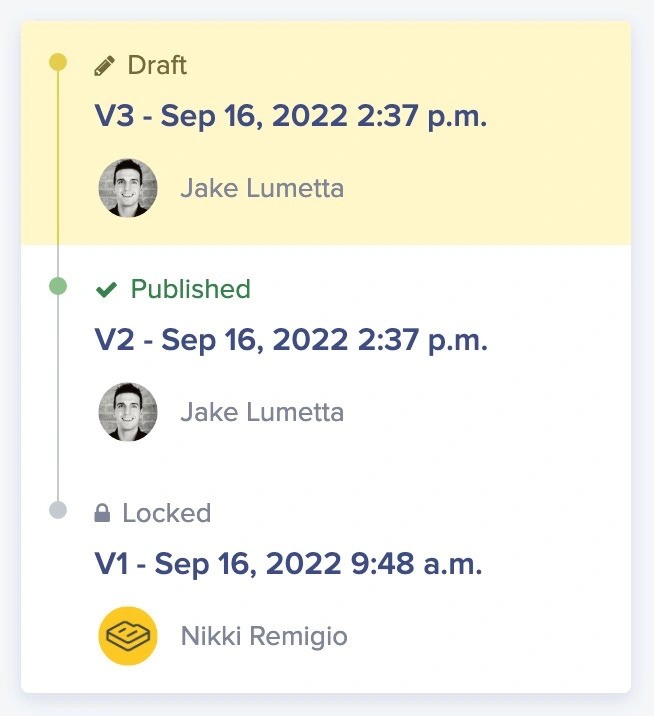
Additionally, there are workflows that allow you to specify who needs to review or approve content at each stage, assign tasks, and track the progress of content through each phase.
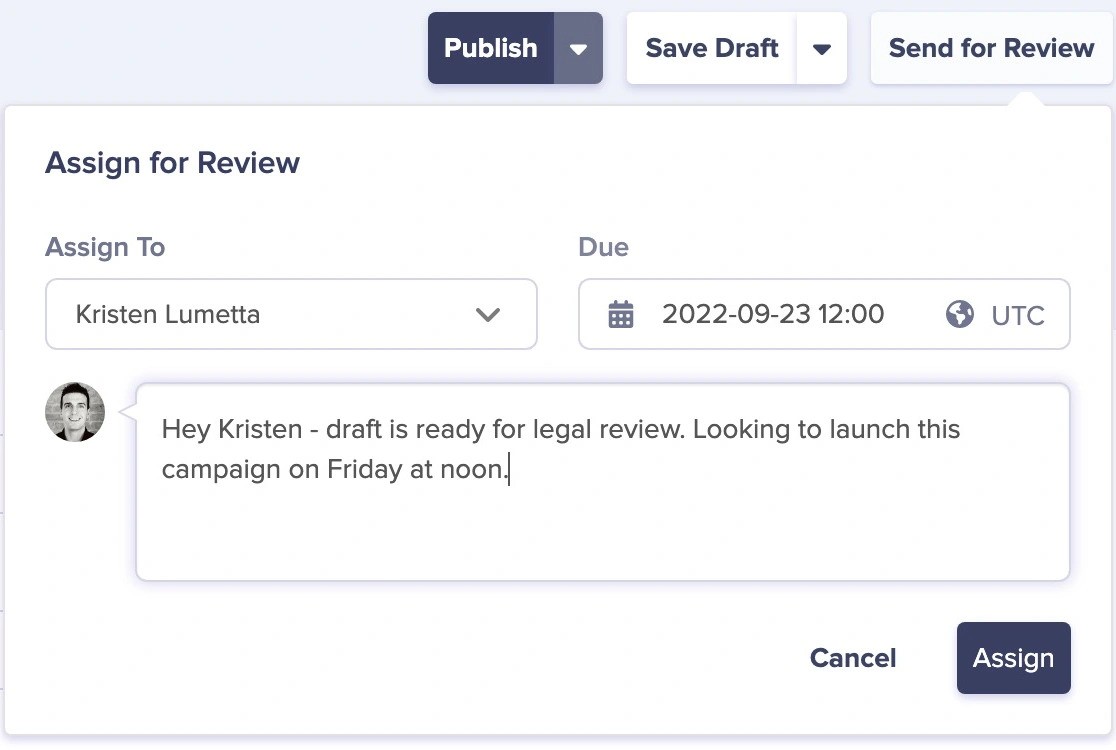
Step 4: Develop a structured content creation workflow
It’s time to create a structured content creation workflow. This requires outlining all the stages and milestones involved with content creation and setting clear time frames for each. If you’ve executed the previous steps, this shouldn’t take long. Here is a general guideline:
-
Ideation and planning (1-2 weeks): Brainstorm content ideas, conduct keyword research, and develop a content calendar aligned with your overall marketing goals.
-
Content creation (1-2 weeks): Writers, designers, and other content creators develop content pieces based on the approved plan(s).
-
Internal review (1-2 weeks): Editors provide feedback on accuracy, brand alignment, and style.
-
Feedback and revisions (2-3 days): Writers make the necessary changes based on feedback.
-
Legal and compliance review (optional, variable time): If necessary, the legal or compliance team reviews content to ensure adherence to relevant regulations.
-
Subject matter expert review (optional, variable time): If necessary, subject matter experts review the text for technical accuracy.
-
Editing and formatting (1 week): Editors and marketing coordinators thoroughly check for accuracy, tone, style, and compliance.
-
Final approval and publishing (2-3 days): Management/executives provide the final approval, and the content is uploaded to the CMS to be published.
-
Promotion (ongoing): Content is promoted on social media and other channels.
Note that these are estimated timeframes and may vary depending on your team size and content complexity.
For easier understanding and visualization, let’s walk through a hypothetical scenario for a manufacturing company. Here’s how a content workflow could look for a blog post on "The Top 5 Benefits of Using Widget X for Your Business"
-
Ideation and planning: The marketing team identifies "widgets for business efficiency" as a key target keyword and brainstorms content ideas. (1 week)
-
Content creation: A content writer drafts the blog post, incorporating relevant research and data on widget benefits. (2 weeks)
-
Internal review: An editor edits the piece, adds their comments to a Google Doc, and sends it back to the writer. If you’re using a CMS such as ButterCMS, you would save your page as a draft, leave comments, and send it back to the writer via the Workflows feature. (1 week)
-
Feedback and revisions: The writer incorporates all the comments to produce an updated version. The editor approves it. (3 days)
-
[A legal review is not deemed necessary]
-
Subject matter expert review: An SME reviews all the product specifications of Widget X in the blog. (5 days)
-
Editing and formatting: A marketer and an editor collaborate to polish the content for grammar, clarity, and SEO best practices. (1 week)
-
Final approval and publishing: The marketing director grants final approval, and the blog post is published. (2 days)
-
Promotion: The social media executive initiates a campaign to promote the piece.
Step 5: Implement tools and software to simplify and automate tasks
A well-oiled content creation machine requires the right set of tools. For large organizations, these tools can streamline tasks, automate processes, and free up valuable time for the team to focus on high-value content creation. Here are some tools to consider:
ButterCMS
ButterCMS is a cloud-based, enterprise-ready headless CMS that simplifies content management and quality control at scale. Here are some of the ways it can enhance your content approval process:
-
Use Workflows to send reminders to stakeholders and track progress.
-
Set up roles and granular permissions for all team members.
-
Roll back to older versions with a single click.
-
Leverage the Write API to automate the translation of your content to as many languages as needed.
-
Model, define, and manage all of your content types from a single source of truth.
-
Use the centralized content repository to serve content to all your frontend applications.
Trello
Trello is a powerful project management tool that can help manage and track the entire content lifecycle. You can create boards for each content piece, add tasks, assign them to team members, and set deadlines. Trello’s sleek visual interface makes it easy to see where each piece of content is in the workflow.
Grammarly Business
An advanced writing assistant for producing content that is clear, error-free, and aligned with your brand’s tone of voice. Grammarly automatically checks for grammar, punctuation, style, and plagiarism, saving time for editors and proofreaders. Integrate it into your workflow to reduce the time spent on revisions and improve the overall quality of your content.
Step 6: Set up review and feedback loops
Feedback loops are essential for continuous improvement in the content approval process. Here’s how you can go about establishing them:
-
Designate specific individuals for each review stage. Ensure that they understand their evaluation criteria and deadlines for providing feedback.
-
Implement a streamlined way to set up a content piece for review. For example, you could use ButterCMS’s approval workflow feature to initiate approval workflows, assign reviewers, and add due dates.
-
Establish clear communication channels for reviewers to provide feedback. This could be through the headless CMS comment function, email threads, or dedicated feedback forms.
-
Encourage open communication between reviewers and content creators. Creators should feel free to ask clarifying questions to address feedback effectively.
-
Integrate ample time for revisions so that the final content reflects your team’s collective expertise.
Step 7: Train, monitor, evaluate, and optimize periodically
Just like any successful system, a content approval process requires regular maintenance and optimization to function at the highest level. Here are some tips in this regard:
-
Empower your team: Educate all stakeholders involved in the content creation process on the defined content approval process. This will help them understand their roles and the rationale behind each stage.
-
Track key metrics: Monitor the performance of your content approval process by tracking relevant metrics, such as cycle times for content creation and average number of revisions per piece.
-
Identify bottlenecks: Analyze the data to identify any bottlenecks or inefficiencies within the workflow. This may involve delays at specific stages, redundant review steps, or unclear communication channels.
-
Continuously improve: Make data-driven adjustments to optimize the content approval process. For example, you may streamline workflows, revise training materials, or implement new tools to address identified challenges.
To understand how this step would pan out in real life, let’s consider an example:
Scenario: After implementing a new content approval process, Acme Pharmaceuticals monitors the average time it takes to move content through the review stages. They discover that the legal review is causing a bottleneck.
Action: Acme conducts a training session to discuss the legal review expectations and the implementation of a legal review checklist for faster turnaround times.
Content approval process example
In this section, we'll walk you through creating a basic content approval process for launching a landing page on ButterCMS.
- We start by logging in to the ButterCMS dashboard and creating the following custom roles: landing page creator, landing page editor, and landing page manager. Granular permissions enable us to grant publishing rights to the Manager role, but only for the 'Landing Page' content type.
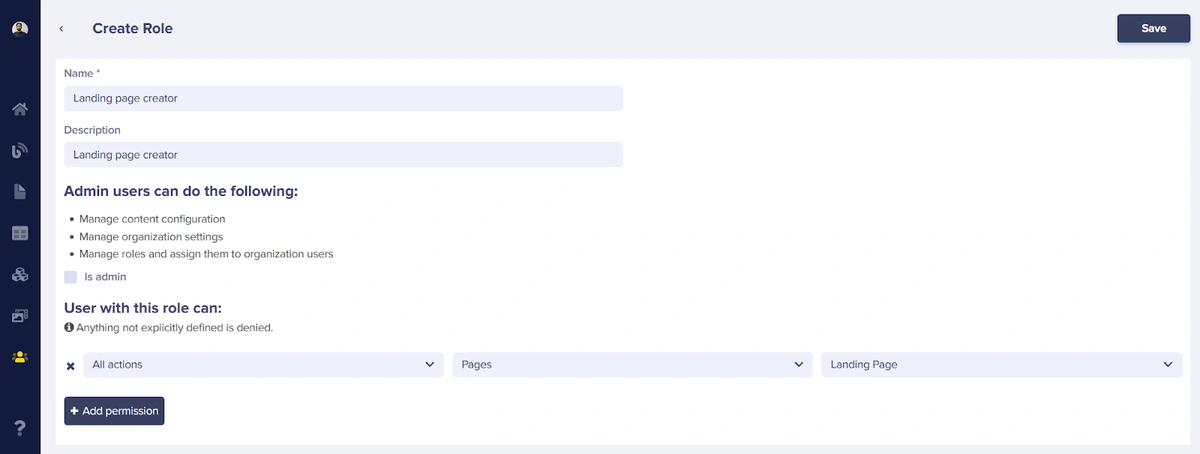
2. Then, we create different users for our creators, editors, and manager and assign the respective roles to them.
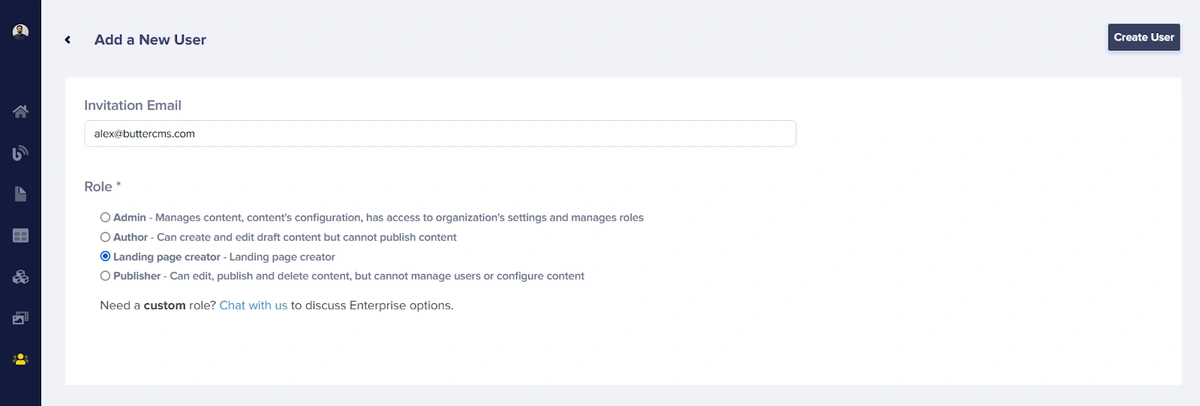
3. The creator puts together a new landing page titled “React Native CMS.”
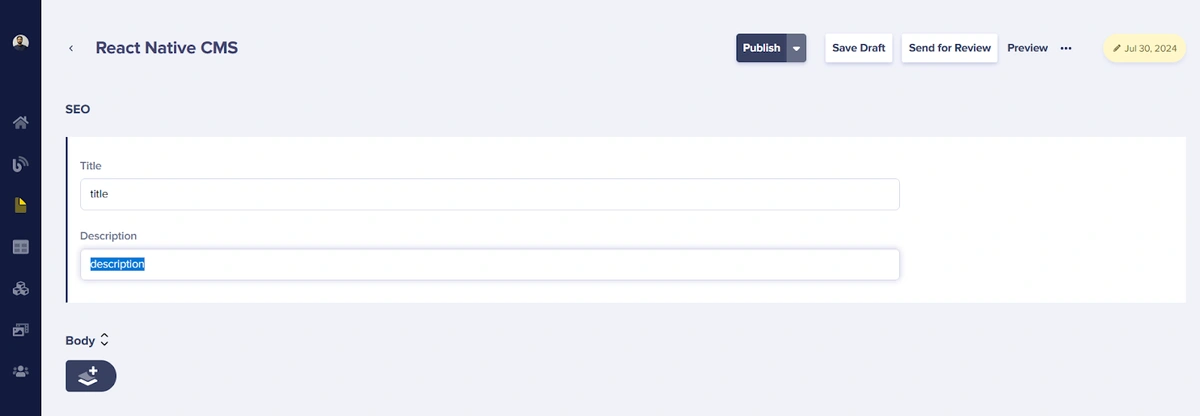
4. Once complete, they click the “Send for Review” button to assign the landing page to the editor for review. They set a deadline of two days.
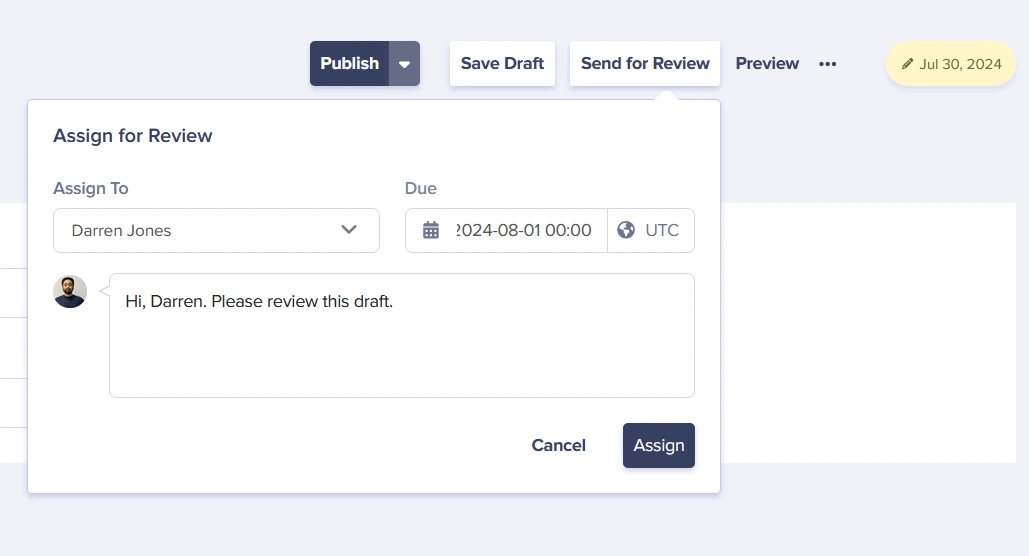
5. The editor receives a notification for the review request. They review the content and layout, provide feedback, and assign it back to the creator.
6. The creator implements the feedback and requests another review from the editor.
7. The editor reviews and approves the landing page and assigns it to the manager for final review and publishing.
8. The manager reviews the landing page and publishes it.
Common issues found in enterprise content approval processes
Next, let’s explore some common roadblocks that can hinder efficiency and slow down content production:
-
Lack of clear guidelines: Without well-defined guidelines, stakeholders may have different interpretations of what constitutes acceptable content, leading to inconsistent feedback, lower quality content, and prolonged approval times.
-
Inefficient communication and collaboration: Siloed workflows, distributed content repositories, and a lack of centralized communication platforms can make it difficult for teams to collaborate efficiently.
-
Limited visibility and tracking: An inability to track content progress through the approval process can make it difficult to identify bottlenecks and hold contributors accountable.
-
Overly rigid process: While structure is necessary, overly rigid approval processes can stifle creativity and slow down content production. For example, requiring multiple rounds of approval from multiple departments for even minor edits can limit agility.
-
Outdated tools and manual workflows: Reliance on outdated tools or manual processes can slow down content creation, especially when you are dealing with voluminous content./p>
Best practices to overcome common issues
Mitigate the above issues by following these best practices:
-
Develop a Responsibility, Accountability, Consultation, and Inform (RACI) chart that outlines who is Responsible for each task, who is Accountable for the final outcome, who needs to be Consulted for input, and who should be Informed of updates. This will eliminate confusion and ensure that everyone understands their part in the process.
-
Develop and distribute comprehensive guidelines that outline quality standards, brand voice, legal requirements, and review criteria.
-
Use a modern headless CMS, like ButterCMS, to automate scheduling, version control, and approval workflows and enable real-time collaboration among writers, editors, and marketers.
-
Design a flexible approval process that allows for concurrent reviews and adjustments as needed, which will prevent bottlenecks and allow for quicker turnaround times (without compromising quality).
-
Regularly evaluate and optimize the content approval process based on feedback and performance metrics.
Final thoughts
By implementing a well-designed content approval workflow, enterprises can strike the perfect balance between speed, creativity, and quality. However, effective content approval is just one piece of the puzzle. To truly optimize your content operations, it’s crucial to address broader enterprise content management challenges. For a deeper dive into these challenges and strategies to overcome them, check out our blog post on Enterprise Content Management Challenges and How to Avoid Them.












